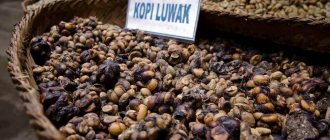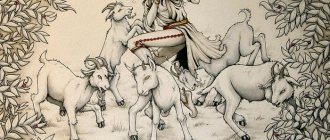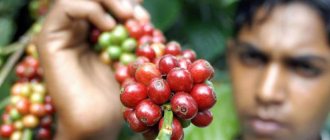Ethiopian legend: an accidental find
The most popular origin story of coffee tells of a young goat herder, Kaldi, from the Ethiopian province of Caffa, who lived around the second half of the sixth century. According to legend, he noticed that his goats were extremely energetic and did not want to sleep all night after eating the berries of a certain tree.
The young man reported his discovery to the abbot of the local monastery, who decided to brew a drink from these berries. The monk found that after drinking the drink, he remained energetic throughout the long hours of evening prayers. Soon the news about the miraculous cure for fatigue spread throughout the monastery.
As knowledge of coffee spread eastward, coffee beans began traveling around the world.
Which country is the birthplace of coffee?
The history of the drink is shrouded in mystery: no one knows exactly where and when coffee beans were first found. There are several legends about how people learned about coffee.
The Legend of the Shepherd Kaldim
The first mentions of coffee beans were found in records made in the 5th century. It is said that in the vicinity of Kaffa, the shepherd Kaldi, or rather his goats, found coffee. The animals became interested in the green bushes with red berries and began to eat them. Kaldi noticed that after eating the goats became active and excited. Out of interest, the shepherd tried the berries. He noticed that they relieve fatigue and give vigor. Kaldi shared the find with his relatives and friends. They began to soak the berries, make a decoction from the leaves and drink them.
The Legend of the Ethiopian Doctor
According to this legend, an Ethiopian doctor noticed a bush with fragrant flowers. He collected the leaves and fruits, soaked them and tried the drink, after which he felt a surge of energy and decided to add coffee decoction to his medicine. He kept his medicine a secret: he passed on the recipe to his son while he was dying.
The Legend of Muhammad and Gabriel
Archangel Gabriel healed Muhammad and brought him back to life with coffee infusion. According to legend, Muhammad was dying for several days and no means helped him. The black elixir brought him back to life. By the way, this legend also took place in Ethiopia.
The Legend of Sheikh Omar
The Yemeni Sheikh Omar was in exile and hiding in a cave. One day, waking up early in the morning, he noticed a bird on a beautiful tree. The white flowers and red berries growing on it caught his attention. The Sheikh collected them and tried them. Omar liked the taste so much that he collected these fruits all his life.
Based on the legends, it turns out that the birthplace of coffee is definitely Ethiopia. However, not all varieties are native to Africa.
Arab Peninsula: plantations and first trade
The history of coffee (judging by the first mentions in written sources) continues on the Arab Peninsula. The grains found by an Ethiopian shepherd were brought here, and coffee was first cultivated and sold here. By the 15th century, coffee was grown in Yemen, and in the 16th century it was known in Persia, Egypt, Syria and Turkey.
Coffee was drunk not only at home, but also in special coffee houses that began to appear in the Middle East. The drink became increasingly famous and people preferred it as an accompaniment to any social activity.
People began to visit coffee houses not only to enjoy a drink and chat, but also to listen to music, watch performances or play chess. Such institutions very quickly turned into centers for the exchange of information, which is why they soon even began to be called “schools of wisdom.”
Thousands of pilgrims from all over the world who visited the holy sites of Mecca every year continued to spread the knowledge of Arabi wine.
Data
Interesting facts about coffee have appeared over the years, so now there are a great many of them known. Let's take a look at some:
- This drink is the most popular in the world.
- In Japan, a holiday appeared in his honor. Coffee Day is celebrated on October 1st. Japan ranks third in terms of consumption of this drink.
- There is a Musanga animal that eats only coffee beans, and its excrement is then used to make a drink. By the way, it is the most expensive in the world.
- The lethal dose is 100 cups per day. If you drink such an amount, a person’s heart will not stand it.
- Coffee, if you do not add sugar, cream and milk, is an absolutely calorie-free drink.
- When this drink appeared in Russia, people did not immediately recognize it. Therefore, supporters of Peter I began to invent stories about him so that he would become popular.
- A cup of coffee won't hurt anyone. It is believed that it is safe to drink no more than 500-600 ml per day, that is, approximately 3-4 cups of 150 ml.
- Drinking the drink helps prevent Parkinson's disease, dementia, and coffee, being a strong antioxidant, prevents the formation of cancer cells.
- Coffee is used in cosmetology. In some countries they take baths with it to make the skin elastic. There are also many recipes for scrubs and masks based on ground grains.
- This drink inhibits the development of gallstone disease.
- It can also cause heartburn. The reason for this is the acid contained in it.
The history of coffee in Europe
European travelers to the Middle East returned home with stories of an unusual dark drink.
By the 17th century, coffee had spread to Europe and was becoming popular throughout the continent. Some people reacted to the new drink with suspicion or fear, calling it “Satan’s bitter invention.” The clergy condemned coffee when it arrived in Venice in 1615. The controversy was so great that Pope Clement VII was forced to intervene. He decided to try the coffee before making his decision. He liked the drink and gave his approval.
Despite heated debates, coffee houses quickly became centers of social life in Europe in the main cities of England, Austria, France, Germany and Holland. “Penny universities” appeared in England: the name came from the popularity of coffee establishments where people socialized and spent time over a cup of coffee that cost one penny.
Gradually, coffee began to replace the usual breakfast drinks of that time - beer and wine. Those who drank coffee instead of alcohol started the day feeling refreshed and energetic, and not surprisingly, their work performance improved significantly.
By the mid-17th century, there were more than 300 coffee houses in London, many of which acquired regular customers, including merchants, suppliers, brokers and artists.
Thus, travelers from Europe contributed to the history of the creation of coffee and coffee culture in the western part of the world.
Legends about the origin of coffee
The history of coffee comes from Ethiopia, which says that Sheikh Omar was the first to discover the amazing properties of the beans. He was a fairly talented doctor, capable of curing even those whom a number of other doctors considered hopeless. One day while walking, he noticed a tree with pleasantly smelling flowers. The healer immediately wanted to know about the properties of the unusual plant. Sheikh Omar managed to prepare a decoction based on coffee seeds. He took it for several days. After a while, the healer noticed that his mood became better and his performance increased.
Having learned about these properties of the plant, the healer began adding a decoction of coffee beans to the healing tinctures. Surprisingly, the drugs were more effective in combating indigestion and headaches. For a long period, Sheikh Omar kept his discovery secret, but before his death he told his son about it. Thanks to this, the drink became known to the world.
Another legend says that the Archangel Gabriel himself presented the dying prophet Mohammed with a vessel filled with a dark liquid. After he drank this drink, he managed to knock forty knights out of the saddle and create an Islamic empire.
There is also a legend that the Yemenis, enslaved by Ethiopia, were the first to start cooking and drinking coffee. Peasants discovered that a drink made from the crushed pulp of coffee fruits helped refresh them when doing grueling, hard work.
New world: from tea to coffee
In the mid-17th century, coffee was brought to New Amsterdam, later called New York by the British.
Although coffee shops sprang up quickly, tea continued to be the drink of choice in the New World until 1773, when colonists rebelled against a heavy tax on tea imposed by King George III. The uprising known as the Boston Tea Party forever changed American preferences: coffee took precedence. First chosen as a replacement for their favorite drink, the population liked coffee so much that even the reduced tax did not encourage people to return to tea.
Unusual coffee traditions
There are certain standards for preparing popular types of coffee. Serving and traditions may differ in different countries. There are unusual drinks using coffee.
Traditions and customs in different countries:
- In Ethiopia, the invigorating drink must be prepared and served only by the owner of the house. Coffee should be served in order of precedence. If a guest refuses a treat, it is considered an insult. Cloves are added to the drink. It is customary to eat it with butter. Interestingly, salt is often added instead of sugar.
- The owner of a coffee shop in Iraq is considered a very respected person. In such establishments, men gather to socialize, watch TV and spend their leisure time. In this country it is indecent to drink more than 3 cups of coffee. A freshly prepared drink made from natural grains is valued.
- In Ecuador, coffee is brewed very strong, it is immediately mixed with sugar and cooled. This mixture becomes thick and is stored in the refrigerator. To make coffee, you just need to add the prepared mixture to boiling water to taste.
- Japan has long been considered a tea-consuming country. Today, coffee has become an everyday drink just like tea. In large cities there are many self-service machines on the streets. You can drink a natural drink in various establishments. The Japanese prefer lightly roasted beans. On October 1, the country celebrates a holiday called “Coffee Day.” In Japan, you can find Jamaican (the country is a leader in the import of elite BlueMountain coffee), Kenyan, Guatemalan, Brazilian and Nicaraguan coffee.
- Residents of Thailand prefer a strong drink. Mainly various finely ground and dark roasted varieties from Indonesia are used. A special feature of making coffee is mixing the beans with wheat, sesame or rice. Thais prefer a sweet drink with a lot of milk added.
- Malaysians drink mostly medium or dark roasted coffee beans. It can be served with milk or ice. In Malaysia, they sell packaged coffee mixed with sesame or cocoa.
- Coffee is the national drink in Yemen. The grains, along with the soft shell, are fried on a baking sheet and then crushed in a mortar. The drink is prepared in a special way: in a Dahl coffee pot, the coffee is brought to a boil twice, after which ginger is added. At the birth of a child, parents treat friends and relatives to an invigorating drink with cardamom. Sugar is rarely added to coffee; it is usually eaten with dates.
- The Vietnamese prefer to drink the drink cold. It has a high strength. Coffee is brewed in small portions and drunk in small sips through a special mesh filter made of metal.
- Damascus produces unusual coffee. It cannot be called a drink. A drop of a thick brown mixture rests on the bottom of the bowl. You need to lightly touch it with your tongue. First, a person feels a burning sensation, then there is vigor and a surge of strength.
- In Finland, a small piece of leipäjuusto cheese is placed at the bottom of the cup. Coffee is poured on top. As a result of exposure to high temperature, the cheese melts. The taste of the drink is unusual, slightly sweet. After the coffee is drunk, the remaining cheese is eaten.
- In Greece, there is a tradition: if a girl makes her boyfriend coffee with thick foam, it means she likes the young man.
Plantations around the world
Briefly, the history of coffee is the history of the spread of the drink one by one from one part of the world to another, so as demand increased, competition for the cultivation of coffee appeared outside of Arabia.
Eventually, in the 17th century, the Dutch managed to obtain seedlings. Their first attempts to grow grains in India failed, but they had some success in Botavia on the island of Java (now part of Indonesia).
The trees grew, and soon the coffee trade began to develop in Holland. Further, the cultivation of coffee trees expanded to the islands of Sumatra and Sulawesi.
Appearance in Latin America
In 1714, the mayor of Amsterdam presented the French King Louis XIV with a coffee tree seedling. The king ordered it to be planted in the Royal Botanical Garden in Paris. In 1723, a young naval officer, Gabriel de Clue, received a sapling of the royal coffee tree. Despite a difficult voyage - terrible weather, a saboteur trying to destroy the plant, and a pirate attack - the officer managed to transport the coffee tree safely to Martinique (Antilles in the Caribbean).
The planted tree blossomed, and over the next 50 years, about 18 million coffee trees grew on the island. A seedling exported from France became the progenitor of all coffee trees on the Caribbean island, South and Central America.
Brazilian coffee owes its existence to Francis de Mello Paletta, who was sent by the emperor to French Guiana to buy beans. The French did not want to share, but the wife of the French ruler, enchanted by Francis, gave him a huge bouquet of flowers before he sailed from the island. Hidden in the flowers were enough beans to begin cultivating coffee.
Missionaries and travelers, traders and colonists continued to bring coffee beans to new lands. So, trees were planted all over the world. By the end of the 18th century, coffee had become one of the most profitable agricultural crops for export.
Loss of monopoly on coffee production
The Arabs and Turks had a monopoly on coffee production for a long time, but everything did not last forever, especially since there was one European country that perfectly mastered shipbuilding and traded with the whole world. Once, she already managed to bypass the Turks in the lucrative spice trade by finding sea routes that passed through territories not subject to Turkey. These were the Dutch, and they were also interested in the coffee trade.
At the end of the 17th century, an event occurred that changed coffee history: a ship from Amsterdam arrived at the port of Mocha, from which tons of green coffee had been shipped for 300 years. There were sailors on the ship who were able to buy a live coffee tree from the farmer. Having carried it secretly onto the ship, they did not yet fully realize what they had done, because this was the starting point in the loss of the monopoly on coffee production.
The expansion of this stolen coffee tree began, first spreading to the Dutch colonies in Indonesia, then the French in the Caribbean, and then overtook Brazil, which would later become the largest coffee producer in the world.
Try our coffee
Mix of grains
Espresso coffee
Blend of 100% Arabica beans. The aroma reveals notes of roasted peanuts and hazelnuts, while the taste is dominated by dark chocolate and walnuts. Soft aftertaste of cocoa and burnt sugar.
Peru
Coffee "Chanchamayo"
Rich and strong coffee with notes of bread in the aroma.
Brazil
Coffee "Santos"
The aroma is dominated by spices and cocoa. The soft nutty-chocolate taste is offset by a slight sourness at the end.











